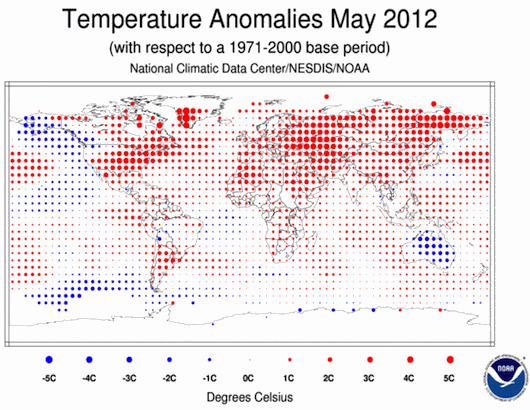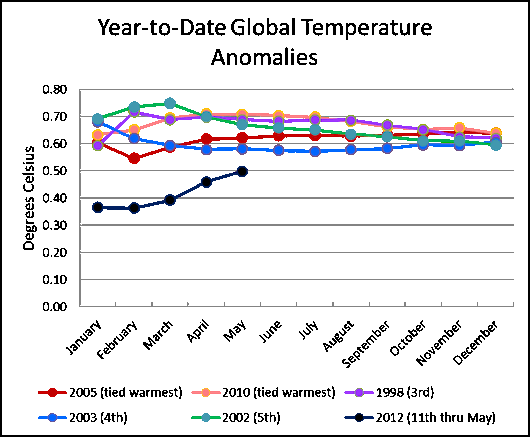NOAA: Second Hottest May On Record Globally, Hottest For Northern Hemisphere

NOAA has released its “State of the Climate Global Analysis” for May 2012. Here are the highlights:
•The combined global land and ocean average surface temperature for May 2012 was 0.66°C (1.19°F) above the 20th century average of 14.8°C (58.6°F). This is the second warmest May since records began in 1880, behind only 2010.
•The Northern Hemisphere land and ocean average surface temperature for May 2012 was the all-time warmest May on record, at 0.85°C (1.53°F) above average.
•The globally-averaged land surface temperature for May 2012 was the all-time warmest May on record, at 1.21°C (2.18°F) above average.
This warmth is particularly impressive because, as NASA noted earlier in the year, “The cool La Niña phase of the cyclically variable Southern Oscillation of tropical temperatures has been dominant in the past three years” – and that is normally associated with cooler global temperatures. NOAA points out, “ENSO neutral” ocean conditions just emerged in May. It’s just hard to stop the march of manmade global warming … other than by reducing greenhouse gas emissions, that is.
Unfortunately, this record-breaking Northern Hemisphere warmth for May is in the worst possible places, with temperatures as much as 5°C (9°F) above the 1971-2000 base period over large parts of both southern Greenland, home to a fast disintegrating ice sheet, and northern Russia, home to vast stores of frozen carbon in the form of the permafrost (aka permamelt).
Last year, a major study by NOAA and the National Snow and Ice Data Center, found that thawing permafrost feedback will turn Arctic from carbon sink to source in the 2020s, releasing 100 billion tons of carbon by 2100. Then Nature published a study waring that thawing permafrost could cause 2.5 times the warming of deforestation. We need to act to reduce emissions quickly before this “anomalous” temperature becomes the norm for the tundra.
As I discussed last week, NOAA said there was a “50% chance” an El Niño will develop in the second half of the year, which NASA says would lead to “rapid warming.” This NOAA report underscores that point, and they provide this fascinating chart (which is year-to-date temps for 2012 compared to other very warm years):

The heat is on. Stay tuned.
You can return to the main Market News page, or press the Back button on your browser.

